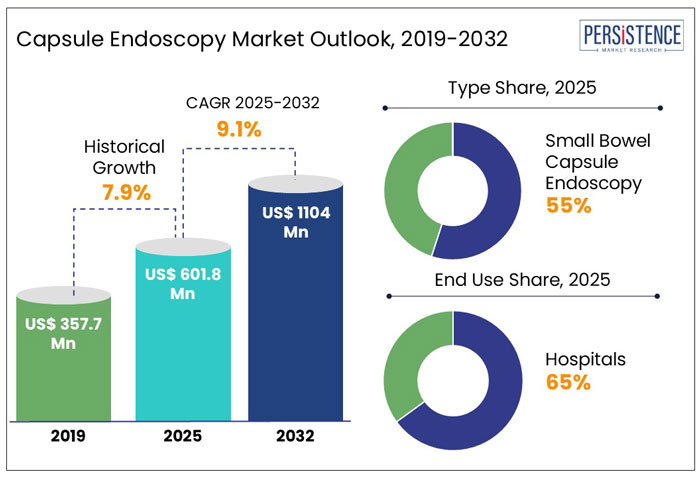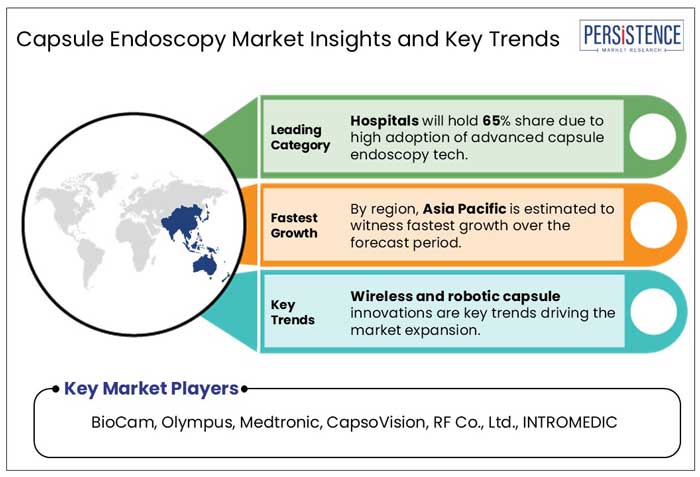Industry: Healthcare
Published Date: March-2025
Format: PPT*, PDF, EXCEL
Delivery Timelines: Contact Sales
Number of Pages: 250
Report ID: PMRREP35168
The global Capsule Endoscopy Market size is anticipated to rise from US$ 601.8 Mn in 2025 to US$ 1104 Mn by 2032. It is projected to witness a CAGR of 9.1% from 2025 to 2032.
In the realm of medical diagnostics, a remarkable transformation is unfolding a story of innovation, precision, and hope. Capsule endoscopy is a technology that has revolutionized gastrointestinal diagnostics.
Imagine a tiny capsule, no larger than a vitamin pill, journeying through the intricate passages of the human digestive system, capturing images and transmitting data without invasive procedures.
Patients and healthcare providers seek accurate, non-invasive diagnostic tools, and capsule endoscopy fits this need perfectly.
The capsule endoscopy market is not just about technological innovation; it's about improving patient outcomes, enhancing the quality of care, and paving the way for a future where medical diagnostics are both advanced and patient-friendly.

Key Highlights of the Capsule Endoscopy Market
|
Global Market Attributes |
Key Insights |
|
Capsule Endoscopy Market Size (2025E) |
US$ 601.8 Mn |
|
Market Value Forecast (2032F) |
US$ 1104 Mn |
|
Projected Growth (CAGR 2025 to 2032) |
9.1% |
|
Historical Market Growth (CAGR 2019 to 2024) |
7.9% |
Rising Cases of OGIB & Colorectal Cancer Aided Market Revenue Pre-2024
During the historical period from 2019 to 2024, the market was steadily growing, fueled by rising cases of obscure GI bleeding (OGIB), Crohn’s disease, and colorectal cancer.
Key players in the industry focused on refining wireless capsule technology, increasing battery life, and enhancing image resolution. However, high costs and limited reimbursement policies restrained widespread adoption, especially in emerging economies.
Real-Time Remote Monitoring to Drive Market Expansion by 2032
Over the forecast period, the market is set for a transformative leap. The integration of AI-powered image analysis, robotic navigation, and real-time remote monitoring will drive unprecedented growth.
The expansion of telemedicine and cloud-based diagnostics will make capsule endoscopy more accessible, improving early detection rates for GI disorders. For patients and healthcare providers alike, this shift represents more than just technological advancement, it’s about faster diagnoses, reduced hospital visits, and improved quality of life.
Rising Prevalence of Gastrointestinal Disorders Driving Market Demand
Every year, millions of people suffer from gastrointestinal (GI) diseases like Crohn’s disease, celiac disease, colorectal cancer, and obscure GI bleeding (OGIB).
Traditional diagnostic methods like colonoscopies can be uncomfortable and invasive, leading to patient hesitation. Here, capsule endoscopy steps in as a game-changer, as it is a painless, ingestible device that captures high-resolution images of the digestive tract.
The demand for non-invasive, patient-friendly diagnostic solutions will fuel the capsule endoscopy market's growth as GI disorders continue to rise due to aging populations, dietary habits, and sedentary lifestyles.
High Cost and Limited Insurance Coverage Restricting Adoption of Capsules
While capsule endoscopy offers a revolutionary, non-invasive alternative to traditional procedures, its high cost remains a significant barrier to widespread adoption.
The price of a single capsule can range from US$ 500 to US$ 1,000. Further, the overall expense becomes a challenge when factoring in additional costs for interpretation, software, and follow-up consultations, especially in developing economies.
Insurance coverage for capsule endoscopy varies widely across regions. In many cases, insurers only cover the procedure if conventional methods like colonoscopy or endoscopy fail. As the market grows, greater insurance inclusion and cost-effective advancements will be key to ensuring broader accessibility and adoption of capsule endoscopy worldwide.
Wireless and Robotic Capsule Innovations are Key Trends Driving the Market Expansion
The next frontier in capsule endoscopy lies in wireless and robotic-assisted capsule technology. Researchers are working on smart capsules with real-time control capabilities, allowing physicians to navigate the device remotely rather than relying solely on passive movement.
Future capsule models could include microscopic robotic arms for targeted biopsies or drug delivery, enhancing both diagnostic and therapeutic capabilities. The innovation could revolutionize gastrointestinal disease management, offering less invasive, more precise treatment options.
As R&D investment continues to grow, wireless and robotic-assisted capsule endoscopy is set to redefine the landscape of digestive healthcare, improving patient outcomes and increasing adoption rates worldwide.
Small Bowel Capsule Endoscopy Led the Type Segmentation with 55% Market Share
Based on type, the small bowel capsule endoscopy leads the market share owing to the rising need for sophisticated diagnostic tools for various disorders. Aimed at delivering efficient and patient-centric options, the segment is further projected to propel, thus resulting in an increase in the introduction of new products.
The increasing disposable income, swift technological progress in capsule endoscopy, increased demand for minimally invasive operations, and the establishment of essential screening programs for efficient cancer diagnosis are significant drivers driving market expansion.
High Adoption of Advanced Capsule Endoscopy Technology by Hospitals Makes it the Leading End Use Segment with 65% Market Share
The hospitals category led the market by end use segmentation, with a revenue share of 65%, and is projected to experience the highest growth rate during the forecast period.
Hospitals have led the adoption of advanced capsule endoscopy technologies, which is the primary catalyst for the segment's dominance.
The extension of advanced capsule endoscopy intends to offer sophisticated diagnostic and treatment services to people. Such advancements are expected to propel segment expansion over the predicted period.

North America Capsule Endoscopy Market Leads the Global Market with 44% Share
The primary reason for the region's dominance in the market is the rising incidence of various diseases in the region, including gastrointestinal disorders such as Crohn's disease, gastrointestinal bleeding, celiac disease, ulcerative colitis, colon polyps, and colon cancer.
Such diseases augment the demand for endoscopic procedures for diagnosis and treatment in North America, which is a key parameter for the market’s growth over the forecast period.
U.S. Capsule Endoscopy Market
The United States led the capsule endoscopy market in the North American region. The growing inclination towards minimally invasive procedures in multiple medical specialties in the U.S., such as gastroenterology, pulmonology, urology, gynecology, and otolaryngology, is propelling the demand for endoscopes. Numerous industry players in the U.S. initially sought FDA approval to launch their products domestically, facilitating market expansion.
Europe Capsule Endoscopy Market to Own Substantial Market Share with Robust Healthcare Infrastructure
The capsule endoscopy market in Europe is projected to experience substantial growth over the forecast period. The comparatively lenient medical device approval process in the region is primarily driving market growth.
Elevated disposable income, the presence of robust healthcare infrastructure, the existence of developed economies, and the availability of proficient personnel are significant factors driving market expansion.
The rising prevalence of cancer in the region, particularly in Germany, is anticipated to enhance the demand for sophisticated diagnostic solutions, including screenings.
Asia Pacific Capsule Endoscopy Market to Record the Fastest Growth Over the Forecast Period
The Asia Pacific capsule endoscopy industry is anticipated to record the most rapid growth by 2032. The market is expected to experience substantial growth due to the presence of a significant number of patient pools with a variety of cancer incidences.
Advanced healthcare systems prioritize innovation, technological advancements, and increasing investments by market players to extend their regional presence.
Various initiatives implemented by private players, as well as expanding healthcare expenditures and enhancing healthcare facilities, are anticipated to stimulate market growth.
The capsule endoscopy market is witnessing intense competition as key players strive to enhance diagnostic accuracy, miniaturization, and AI-powered image analysis.
Leading manufacturers in the industry are investing in wireless imaging technology and real-time data transmission to improve gastrointestinal (GI) disease detection. Startups and emerging players focus on cost-effective capsule endoscopy solutions to make advanced diagnostics more accessible.
With the rising prevalence of colorectal cancer, Crohn’s disease, and small bowel disorders, demand for non-invasive, patient-friendly diagnostics is surging. The race for AI-driven image analysis, improved battery life, and enhanced biocompatibility is shaping the market dynamics.
Key Industry Developments
|
Report Attributes |
Details |
|
Historical Data/Actuals |
2019 - 2024 |
|
Forecast Period |
2025 - 2032 |
|
Market Analysis Units |
Value: US$ Bn/Mn, Volume: As applicable |
|
Geographical Coverage |
|
|
Segmental Coverage |
|
|
Competitive Analysis |
|
|
Report Highlights |
|
|
Customization and Pricing |
Available upon request |
By Type
By Application
By End Use
By Region
To know more about delivery timeline for this report Contact Sales

The market is set to reach US$ 601.8 Mn in 2025.
BioCam, Olympus, Medtronic, are a few leading players.
The industry is estimated to rise at a CAGR of 9.1% through 2032.
The market is anticipated to reach a valuation of US$ 1104 million by 2032.
North America owns the major market share in the global capsule endoscopy.